#Karl Stoecker
Text

Outtake by Karl Stoecker for the back cover of Lou Reed's Transformer album, 1972.
14 notes
·
View notes
Text
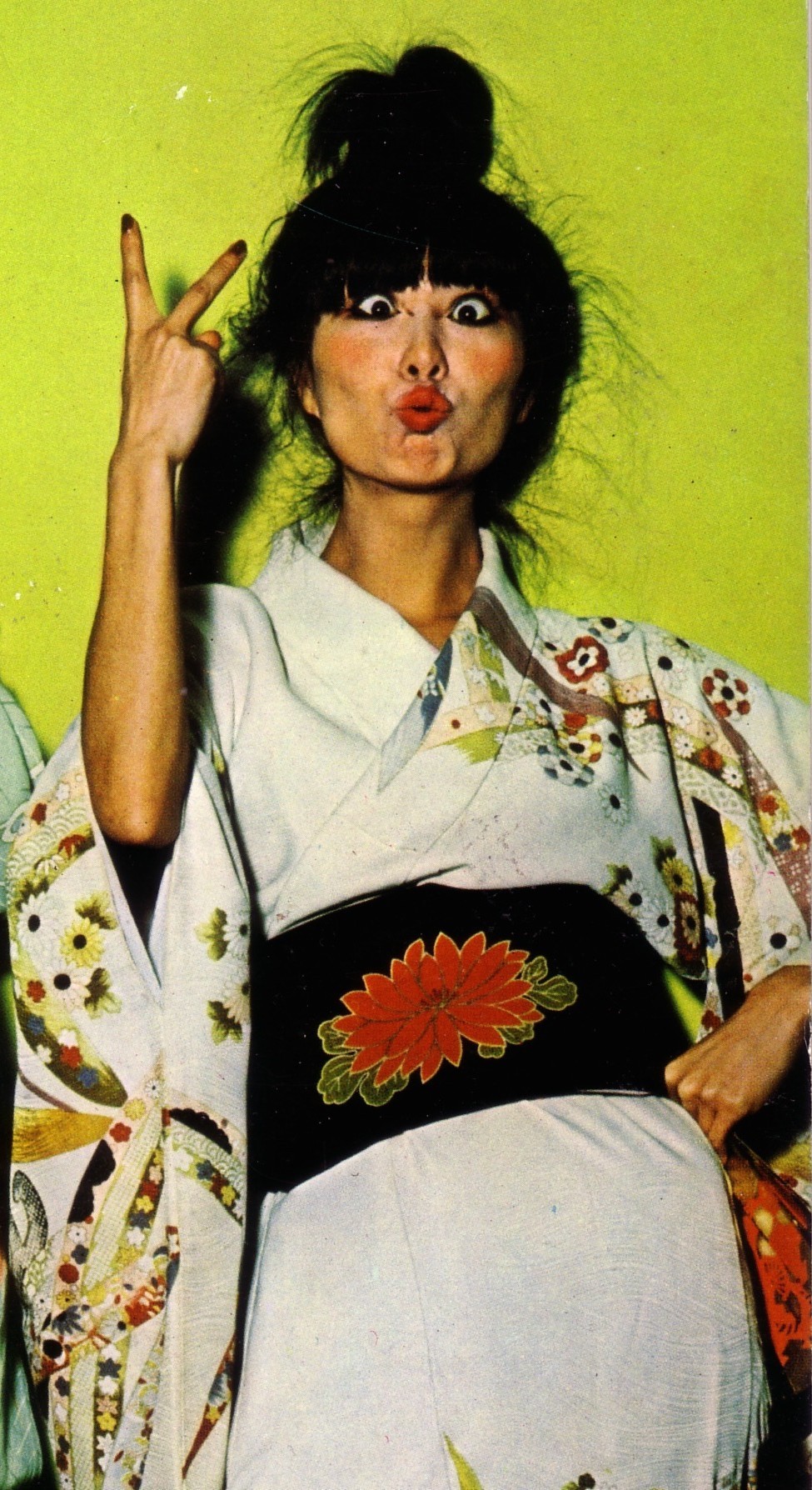
"IS THERE A GEISHA IN THE HOUSE?" -- IN MICHI HIROTA'S OWN WORDS.
NOTE: I cropped the hell out of this "Kimono My House" outtake and am currently using it as my cellphone wallpaper. Michi is such fun to look at!
MADELINE BOCARO: "What led you to become a model on the cover of "Kimono My House"?"
MICHI: "We were both actresses touring with a Japanese theatre company in Europe and the USA. My husband Joji Hirota was musical director. A record company (Island records) approached our director looking for Japanese women, and we were asked to do the modeling. I am the woman on the right (with a fan)."
MADELINE: "Do you know the whereabouts of the geisha on the left?"
MICHI: "I have no news about the other lady since I left the Japanese theatre company at that time, however her maiden name was Kuniko Okamura. She married a Frenchman soon after finishing our tour and bore 4 children."
MB: "What kind of instructions did Ron Mael, or the photographer give you?"
MH: "We were not told much, they just let us move freely. We didn’t know how to arrange our hair properly or how to fix our kimono. There was nobody to dress us. The session took 4 or 5 hours."
MB: "Karl Stoecker also photographed models for the ROXY MUSIC album covers. Did you ever work with him again?"
MH: "I’ve heard that he is the one of the foremost photographers in the world, but unfortunately I never had a chance to work with him. (I would like to, if he is looking for an old Japanese lady!)"
Source: https://madelinex.com/2014/12/25/sparks-iconic-album-cover-kimono-my-house.
#SPARKS#SPARKS band#Michi Hirota#Hirota Michi#Kimono My House#1970s#Kimono My House 1974#Karl Stoecker#Photography#Glam rock#70s fashion#Japanese Dance Company#Sleeve Art#Red Buddha Theatre#Hair and Makeup#Kimono My House 1974 LP#Photoshoot#Photosession#Super Seventies#1974#SPARKS 1974#Vintage Style#Glam#70s#Japanese#Geisha fashion#Avant-pop#Geisha#Art rock#Kimono My House LP
30 notes
·
View notes
Text
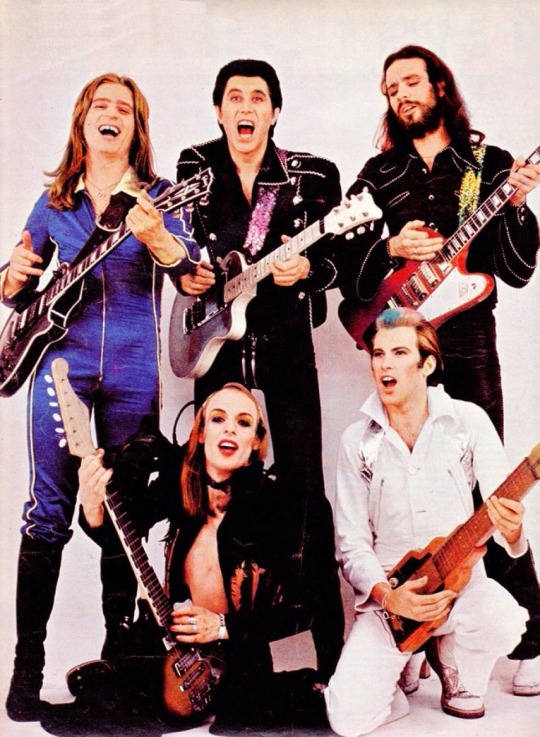
@dark_shark Roxy Music, 1972 by Karl Stoecker #glam #BrianEno #BryanFerry
7 notes
·
View notes
Text

«Kari-Ann Muller: Outtakes from the cover shoot for Roxy Music's debut album by Karl Stoecker»
18 notes
·
View notes
Text
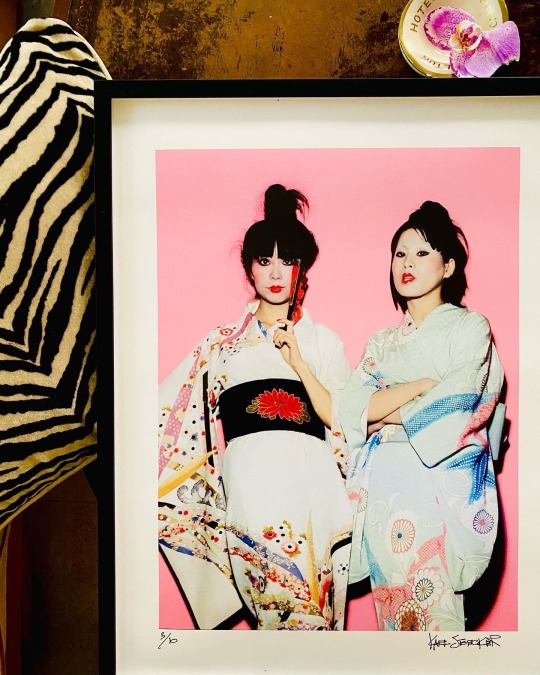



• @pattistoecker Out Take of Karl’s Famous 1974 Album Cover for Pop Duo - Sparks - Kimono My House - one of the two models for the photo -Michi Hirota on the Left in this out take has said ‘I kept one Polaroid photo in which I looked rather kawaii (cute in Japanese), which Karl dropped on the floor. Hope this is OK with him. I keep it in my personal photo album.’ Love That !💗💜
50 notes
·
View notes
Photo
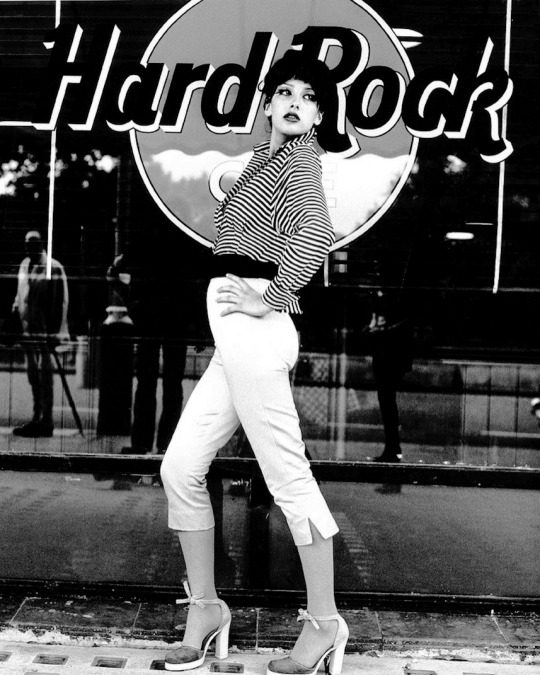
Siobhan for Vogue circa 1973
Photo by Karl Stoecker
111 notes
·
View notes
Photo

+ artist : Sparks
+ title : Kimono My House (1974)
+ art direction : Nicholas De Ville
+ artwork : Bob Bowkett, CCS
+ photography : Karl Stoecker
2 notes
·
View notes
Video
Amanda Lear’s “Follow Me” reminds me of Rayon (not Marc Bolan...)
“Dallas Buyer’s Club” soundtrack + Roxy Music.
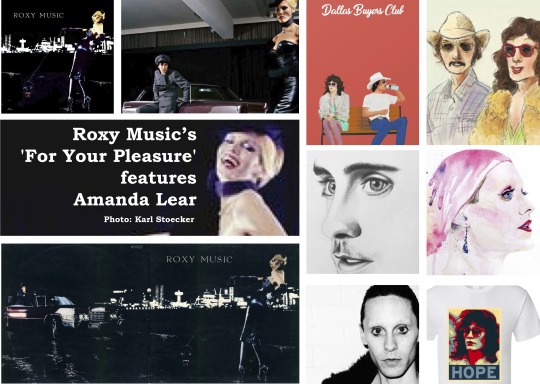


2 notes
·
View notes
Photo

Brian Eno & Bryan Ferry wearing stage costumes, 1973
Photographies by Karl Stoecker.
14 notes
·
View notes
Text


A imagem (que aparece num blog russo como “duas garotas numa festa em Tóquio brincando com as iniciais de Winston Churchill”) dá uma zoada no fato de Winston ter as mesmas iniciais de “water closet”, banheiro. Anos depois, em 1974, o tecladista e compositor Ron Mael, da banda americana Sparks, bateu o olho nessa foto e quis algo parecido para a capa do terceiro LP da banda, Kimono my house. Convidou o fotógrafo das capas dos discos do Roxy Music, Karl Stoecker, para fazer a imagem. Saiu aquela capa que todo mundo conhece.
Fonte:
https://popfantasma.com.br/a-origem-da-capa-de-kimono-my-house-dos-sparks/
#sparks#sparksband#ron mael#russell mael#kimono my house#glam rock#70's music#70's pop#winston churchill#70's rock
15 notes
·
View notes
Text
Your bag is your lifeline
Your bag is your lifeline
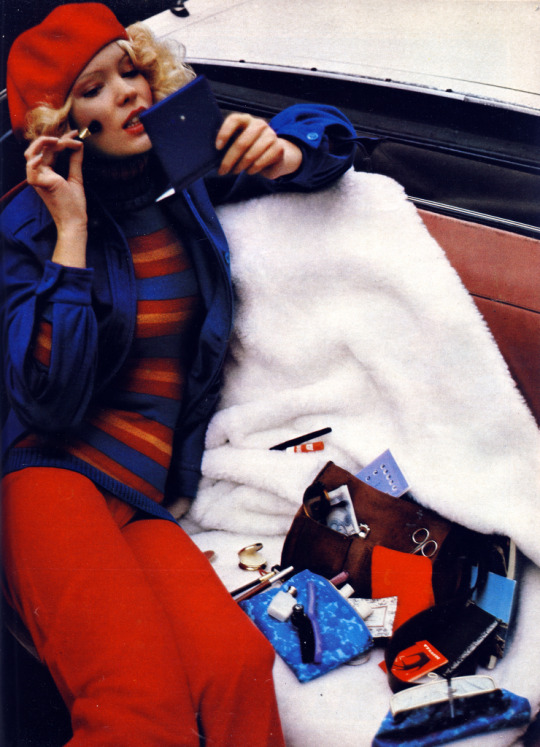
Jumper from Biba. Jacket from Electric Fittings. Trousers from Peter Robinson. Leather bag by Lilley and Skinner.
Photographed by Karl Stoecker.
Scanned from Honey, February 1972
View On WordPress
8 notes
·
View notes
Photo
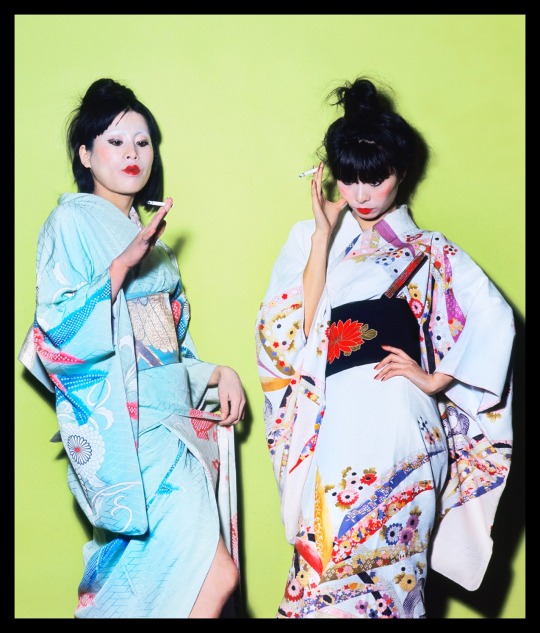
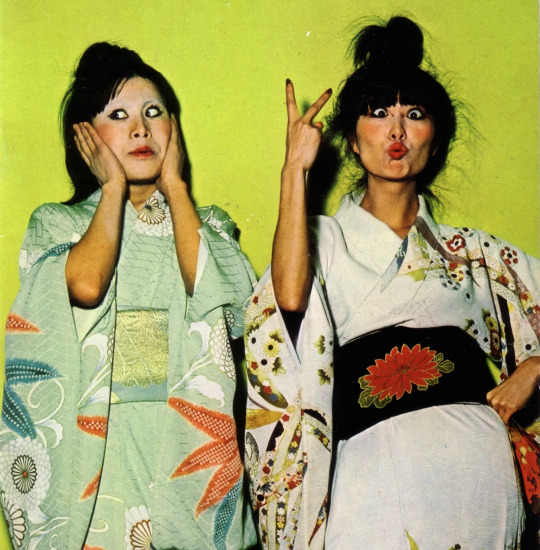
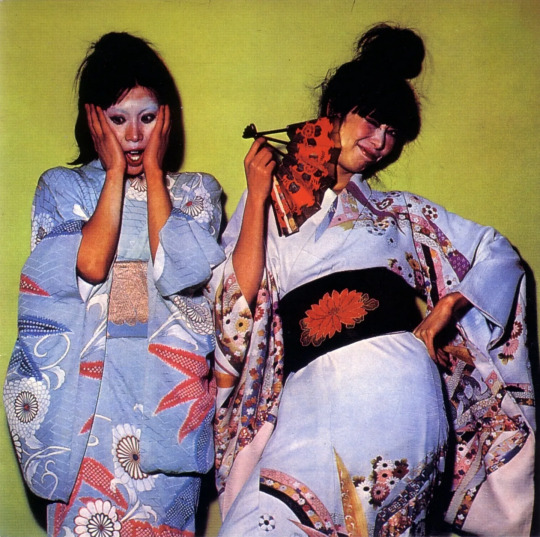
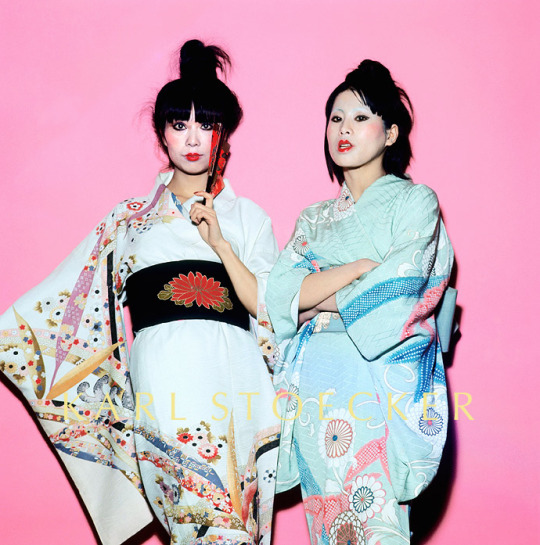
Outtakes from Kimono My House - Sparks
#Kimono My House#Vinyl#karl stoecker#Michi Hirota#Kuniko Okamura#ron mael#russell mael#sparks#sparks band#the sparks brothers#high res#high quality
52 notes
·
View notes
Photo
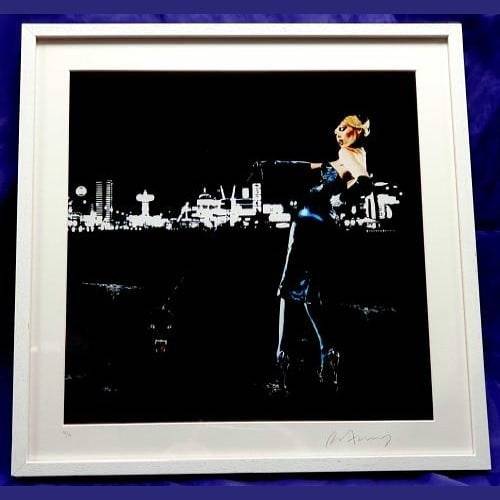
ROXY MUSIC For Your Pleasure. Rare official Autographed 2014 UK limited edition artwork print, featuring the great album artwork by photographer Karl Stoecker in 1972. Printed and framed by industry leaders Metro Imaging, this limited print was a made-to-order fully archival C-Type print, using the latest Lambda printing methods. This nicely framed and glazed print measures 19" square in size, with a white wooden window frame with a matching surround which has been hand numbered & signed by Bryan Ferry in pencil, this example is number 46 from a strictly limited run of 50 copies only. These were only available on-line through the official Bryan website, looks stunning and is a must have for any fan. Available from https://eil.com/shop/moreinfo.asp?catalogid=722223 #eildotcom #eil #records #vinyl #rarerecords #rarelps #rock #pop #cratedigging #vinyljunkie #vinylcollection #recordcollection #vinylporn #instavinyl #memorabilia #autographed #signed #print #roxymusic #bryanferry https://www.instagram.com/p/ByDitMPBHd-/?igshid=19ii76y3hoy67
#eildotcom#eil#records#vinyl#rarerecords#rarelps#rock#pop#cratedigging#vinyljunkie#vinylcollection#recordcollection#vinylporn#instavinyl#memorabilia#autographed#signed#print#roxymusic#bryanferry
0 notes
Text
INTERVIEW: JUSTIN STRAUSS WITH MICHEL GAUBERT

Paris, France
Michel Gaubert, legendary French sound illustrator, is the go-to sonic maven for fashion designers from Raf Simons to Karl Lagerfeld, Loewe to Rodarte. Music obsessed his whole life, Gaubert’s record collection is a behemoth, physical history of his tastes, as is his Instagram account, widely noted for its originality and idiosyncratic visual vocabulary. For this episode of Just/Talk, Ace friend, DJ and music producer Justin Strauss caught up with Gaubert at his home in Paris to talk about the downfall of Champs Discques, if Paris or New York has better nightclubs and what it’s like to soundtrack a Chanel show.
Justin Strauss: For me, fashion and music have always gone hand in hand. When I was a kid, I saw The Beatles and that changed my life musically. Seeing the way they looked, how they dressed played a huge part. What was your inspiration? When did your love affair with music and fashion start?
Michel Gaubert: It started at a very early age because my mother was very much into fashion. She had a bookstore, and we would get all the magazines at home, and I was watching those TV programs, and I liked the whole thing — just like you.
I thought there was more to music, more to music than just the actual music. There was also the lifestyle — I mean I don’t like that word, “lifestyle,” but they dressed to represent themselves because I think representation is also a part of it, part of the music, like the artwork on records. I was conscious of that. I think the biggest revelation for me was David Bowie and Roxy Music because they were performers. And then Patti Smith came along with a whole different thing where style meant something.
JS: So was it David Bowie for you, your inspiration?
MG: Yeah, there was so much about him. I listened to the record Hunky Dory, the back cover with him wearing the large pants and the whole thing… Oh my God it was interesting. Ziggy Stardust came up and I was like “wow.” I loved everything about it, the melody, the lyrics, the aesthetic; it was good.
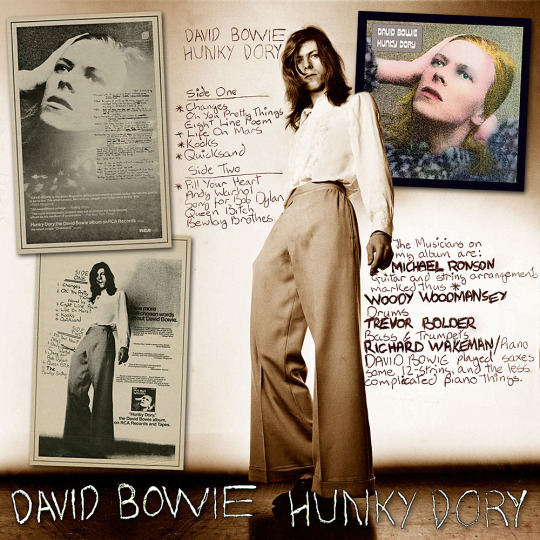
JS: I was lucky enough to see that show.
MG: Oh you were?
JS: Yeah, like you seeing David Bowie, I had already been into The Beatles and the whole British thing from a very young age, and then as a teenager, I was in this band Milk n’ Cookies — and you know, we just loved everything English; and then David Bowie and the whole glam scene came along and it was everything.
MG: And for me, Roxy Music is the same thing. The first three or four years of Roxy Music was absolutely unbelievable. I saw David Bowie when Station to Station came out and for Let’s Dance. With Roxy Music, I saw them quite early on 1976 in Paris when Bryan Ferry was dressed in military, a black tie tucked in and the whole thing. I liked him when he was with Jerry Hall…

JS: The bass player of Milk n’ Cookies played with Roxy Music on tour before he joined the band. David Bowie, Roxy Music and Sparks for me were the biggest. And our band was discovered by Sparks’ managers so we kind of got to be really involved with that.
MG: I loved the guy who did the Sparks album covers Kimono My House and Propaganda.
JS: That guy, Nick Deville, also art directed all the great Roxy Music album covers and did the Milk n’ Cookies album cover as well. They used a few different photographers but he was the art director.
MG: For Roxy Music it was Karl Stoecker.
And it’s funny because at Raf Simons’ show last February, we started the show with that song from Roxy Music, “In Every Dream Home a Heartache.” Because the collection was very black satin, jewelry, colors, all that kind of stuff.
JS: Well, the cover “For Your Pleasure” with Amanda Lear and walking the black cheetah was so striking, and such an important part of the album experience — how sad that is so missing from today’s music scene, the artwork.
MG: It is. I mean I hate cds.
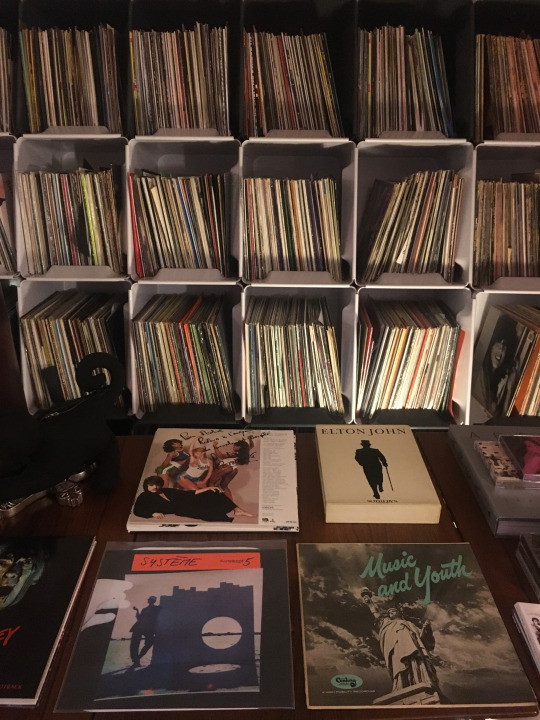
JS: It’s beyond cds now, it’s just something in the air.
MG: I do like to use them, of course, and also digital files. But I still like vinyl, cause when you get a vinyl it’s the whole thing. It’s fantastic to look at. And cds, they never come close with artwork.
JS: So you’re into David Bowie, you’re into Roxy Music, and how did you start working in music as a living?
MG: Well, after spending time in London, I then went for one year to America as an exchange student.
JS: Where? New York?
MG: No, no, no. I went to California. I was sent to California but I was still in school. When I came back to Paris, I didn’t do much for a couple of years and then I started to work in a record store, Champs Discques. And from then I made quite a few friends and people liked what I had to offer. In those days, the record store was much more than it is now, the ones that are left.
JS: You were a curator to your customers. They trusted you and your taste. And the records you would recommend to them.
MG: Yes, exactly.
JS: It was a great record store.
MG: It was fun, I mean I got to know all the DJs in Paris, lots of people came to that store. It was more than a record store, it was an “in” place to go. From working there I got asked to work at Le Palace.
JS: Had you DJ’d before that?
MG: No, no. I did it because they had the main room and then downstairs a roller disco, and I was convinced it was the right thing to do. So they asked me for a different style of music and I just did it. So, of course, there was lots of fashion there at Le Palace.
JS: Le Palace I always related to Studio 54 in New York.
MG: I think it was better. It was that kind of a place where I think it was more cultural than Studio 54. I think it was more refined. Studio 54 was this amazing place when you walked in but then… I thought the balance was bad.
JS: And musically, what were you playing?
MG: Everything. I was playing Rick James, X-Ray Spex, Devo, Talking Heads.
JS: So it was very much like the Mudd Club in New York.
MG: Yes, it was more like that.
JS: But in a fancier place.
MG: Yes, see that’s what I liked about Le Palace. Okay, you’ve got a mixture of the Mudd Club and then Studio 54. Studio 54 is all about the glossy and Le Palace had the mixture of both — it could be dirty also, which I liked — and why I think it’s better.
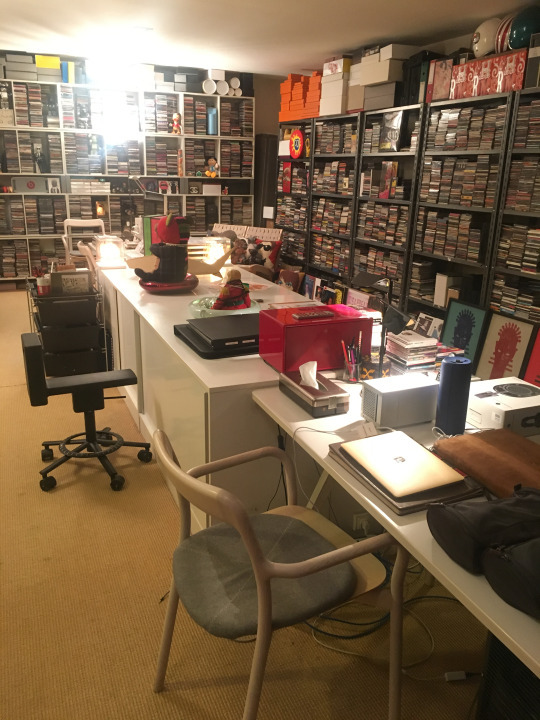
JS: I never DJ’d before the Mudd Club either and I just played what I liked. I didn’t know how to mix records.
MG: Boom, boom, boom, like that. It was just to make sure you caught the end of the record before the next one. They would play weird stuff like Eddie Harris. It was super.
JS: Anything goes.
MG: Everything goes, it was diverse, but I was not playing the Bee Gees. I was not playing that kind of stuff.
JS: Did they play that in the main room?
MG: Upstairs, yes, yes. I mean there was some cool disco stuff but I was more of the alternative thing. And I liked all the new wave, all that kind of stuff, new wave. Gary Numan, B52s…
JS: I guess it’s very similar to what was going on in New York at the Mudd Club, Danceteria, and the Ritz. The Ritz kind of reminded me of Le Palace because the Ritz was an old, beautiful place, kind of like Le Palace, and everyone played there from Human League to Kraftwerk. Back then, I was DJing there at least three times a week. It was crazy, when you think about all the music that came from around that period from so many different places. From punk to funk, to early hip hop, to disco. It was insane.
MG: Yeah, it was a truly crazy era. I don’t want to sound like an old person but it was truly like a beginning of things. I saw a Kraftwerk show in Paris, and they had all those robots on stage and things like that.
JS: Do you mean when Computer World came out?
MG: Probably, yeah.
JS: Because that’s when they played in New York, at The Ritz.
MG: And then I went to New York to the Paradise Garage and they were playing Numbers and all those kids were dancing to Numbers. I said, what?! I like the cross-cultural thing.
JS: I mean that’s funny how our stories are very similar because Afrika Bambaataa used to hang out at the Mudd Club. We became friends and then when I started to work at the Ritz, Kraftwerk were playing and I invited him to the show and that just blew his mind. It was just such a great thing how all the kids who loved hip hop really embraced Kraftwerk.
MG: Of course. A couple of years ago they were sampling New Wave records a lot, all those kids.
JS: Then there was a scene in Paris, I think around the same time, like Z records.
MG: Celluloid Records too.
JS: Yeah, Celluloid Records were filtering into New York and we played all those records at the Mudd Club and Danceteria, they were huge.
MG: Yes, Fab Five Freddy “Change The Beat.” There was good stuff at the time. The thing is, the music in France is different from America. It was more open. I mean America had amazing music, but in Europe there are smaller countries so we were more aware of what was going on around us like what was happening in Germany, Italy and Holland. Plus, in France we were a bit like, deprived musically since we had limited radio and television stations.
JS: You had access to a lot of music, we didn’t have that.
MG: And in America music was either American or British. The rest was more —
JS: We would have to look harder to get it as a DJ. There were little stores like 99 Records or whatever that would bring in the crazy stuff so yeah, we would find it, but it was harder. So how long did you DJ for at Le Palace?
MG: I DJ’d for Le Palace for about 3 years and then I couldn’t deal with it anymore. I was, at the same time, still working at Champs Discques and I was working at Le Palace twice a week. But then that would fuck me over for the week. At the same time I had some friends who were asking me to do music for a fashion show, and I said, “Okay, sure I’ll do it.”
JS: What was the first one you did?
MG: It was a friend of mine, the brand was called Vestiaire. It means “wardrobe,” basically. It was a men’s show in a restaurant. And then some people asked me to do another one, and another one, and then I started to do a bit more and then I got fired from the record store.
JS: Why?
MG: Well the record store was not doing so good anymore because Virgin came next to it and the owner, unlike us, rather than highlighting all the strong points of Champs Discques, he went to compete with them. Like slashing prices, all that kind of stuff. It was the wrong move, it was more an ego trip, but you know.
So I wasn’t there enough probably so he fired me. So I was like “Oh my God!” That’s okay, maybe it’s the kick in the ass I need.
JS: Sometimes those things are the best things that could happen to you.
MG: Yeah, and after I was fired I was like “Shit, I wish he would have fired me earlier.”
JS: I did the same thing, I got asked by Stephen Sprouse to do the music for his first big show which was at the Ritz, and we opened with “Search and Destroy” by Iggy and the Stooges and it was just like the most amazing thing. I’ve done a bunch, but I got into the remixing thing and that took up all my time so I couldn’t really do it so much.
MG: It’s fun, plus it’s good when you find an alter ego to work with. You know when there is a feeling of trust between the designer and you, both ways, when they trust you because they know when you say something, when you propose it, it means something, and also when you trust them. Then you know you can play for them whatever you think is right, and you feel comfortable in that.
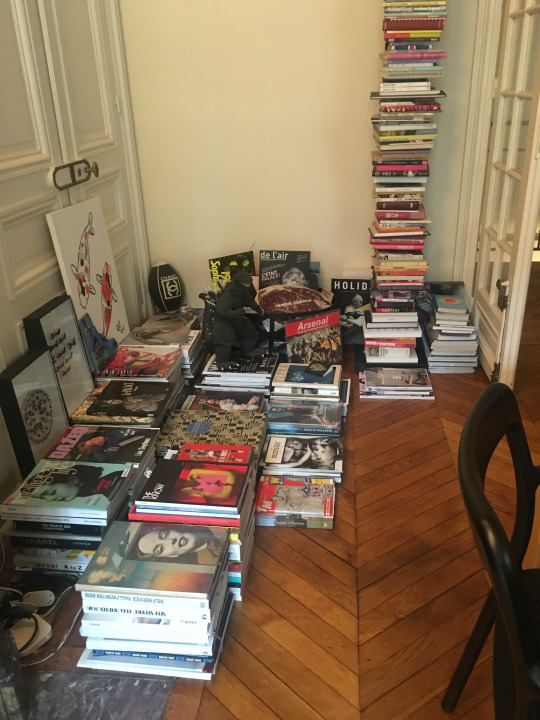
JS: Was there one show that kind of set your career off that was like magic?
MG: Yeah, I think it was the show for Karl Lagerfeld. That one was planned before I left the record store — I knew him from the record store, he was a steady customer. He said “Would you like to do music for my show.” I said “Sure, why not, of course.”
JS: It was huge show obviously.
MG: Yeah, it was a big one and the music was inspired by Malcolm Mclaren’s “House of Blue Danube” and all that kind of stuff. It made my career. I mixed Soul II Soul with Strauss and De La Soul, with opera dialogues, that kind of stuff. It was great.
JS: And were you mixing it live with records back then?
MG: No, no —
JS: You recorded it?
MG: I worked with Dimitri from Paris for the first three years. It was all done reel to reel.
JS: Tape edits?
MG: Yes. It was done like that. I was not able to do it, but he had wonderful fingers and ears.
JS: So now these days when you hear about music and fashion, if there’s some amazing fashion show, it’s probably you doing the music.
MG: There are other people…
JS: Yeah, but you have been super successful at it. Is this still exciting for you?
MG: Yeah, of course. Like I said, when there is this idea of collaborating with someone, it’s exciting. When you know it can push things, like the Chanel show for example, they are big productions. For me, it’s cool, it’s the spectacle. It’s like soundtracking a movie or something that makes it feel different. And then there are people who I like to work with because you know that they have a sense of fashion which is unique and I learn things from them and they learn things from me. So that’s the best part.
JS: Yeah, when those worlds collide and inspire each other. That’s one thing which I always miss about New York and the 80s, when you had Jean-Michel Basquiat, Keith Haring, Andy Warhol, all these artists coming to the clubs, being part of the whole scene. Everyone was intermixing and everybody was inspiring everyone else and that’s a great thing.
MG: It’s more complicated now. They have still this kind of thing. I don’t know if it was in New York, but in Paris we had places you could go to every night and see the same crowd. Now there’s not a club like that. There’s places people will migrate from one place to the other depending on what goes on, so it’s a bit different. I like the idea of having one place to go every night, the same place. You know you don’t have to worry about anybody. And you can say "Hi, how are you? See you tomorrow.” Cause then you would dress up, dress up for the other kids and for yourself.
JS: It was like the first time I went to the Backroom at Max’s Kansas City. Everybody knew each other, everyone was like “Oh who’s this new kid?” Any of those clubs like Area, Mudd Club, everyone knew each other.
MG: That’s cool, that’s cool. Everyone knows each other when I go to a fashion party or something, so it’s part work and part fun.
JS: So when you work with a designer now, do they come to you for ideas and inspiration as well? Is it mutual?
MG: Both, both. There are several ways to look at it. Either I come up with stuff or an idea and some say, “Listen, hey there is this track I like. What do you think?” I say what I think.
JS: You do multiple shows every season. Is that something that’s difficult?
MG: Yes and no. I mean, the shows are now ten minutes long. When I started they were like 35 or 40 minutes, which was super hard to do to keep people’s attention span for 45 minutes. But then, the usual was 45 minutes. Now it’s ten minutes and everyone has a very specific image.
JS: Do you ever find they musically crossover?
MG: Not, not really.
JS: That’s good. Because sometimes there is a theme running through the season and a lot of the designers kind of —
MG: Of course sometimes there is a new big album they all are tempted to use, but I think it’s because of that and also because music is easy to get and not so easy to get. When you are not into music it’s pretty difficult to know what’s going on. People want to make it more individual. If you have a good new record at the right time, then it works. Let’s say I got a record and I know I have a show in three days, then it’s perfectly fine. But if it’s been around for a month, you don’t need it. It’s all a question of timing.
JS: How do you feel about the way music is heard now and how many people don’t buy music? I mean it’s never going back to what it was.
MG: No, I don’t know if it’s good culturally but that’s one thing. Because, at least, like a lot of music I know from the past I grew up with or listened to when it came out. You relate to what’s around you and what it means at the time. There was always a significant connection to be made somewhere with the music. These days, people listen to music all across the board regardless if it’s new, old, whatever. Sometimes a lot of people don’t know how to focus.
JS: There’s no connection like there used to be. It’s very disposable, I find, and people’s attention spans are shorter because of the internet and everything is quick, quick, quick, they don’t take the time to let it really sink in.
MG: But I do the same thing too, sometimes, because there is stuff I want to listen to. I just do something else and put the record on and listen to it at the same time.
JS: Where do you find your music these days?
MG: Everywhere. Everywhere.
JS: Do you still go record shopping?
MG: Not really. Do you?
JS: I mean I try to. But there’s so much new music that doesn’t get released on vinyl so it’s nice to get the record if you love it.
MG: When I like a record and it’s worth it, I get it. The last one I went to was in January and I went to work in London. I bought some stuff because it’s there in front of you. You know, “I don’t have this” or “I don’t have that” and you just get it. As a matter of fact, I think it’s harder to buy them like that because you don’t see as much.
JS: When I DJ, I bring a small bag of vinyl. It’s still great to play, but a USB stick is life-changing. So many great things have come along with the technology and so many not so great things too.
MG: I think it’s great and I think there are bad things too. I think society is too dependent on the machines and a lot of the things that go wrong are also because of the machines. People don’t know what to do if they don’t have their machine. So basically, and me included, it can’t be just that and no USB stick.
JS: That’s pretty standard. It’s become the standard and not the turntable. When it was changing over and you saw these DJs come in and set up their laptop, wires, pulling out everything and then two minutes later the computer would crash, and there would be nothing. Then they would be like “Can you put on a record?” Because the record always works. People have become too dependent on the internet.
MG: Everything, people’s minds, fake news. It’s crazy, it’s very, very crazy.
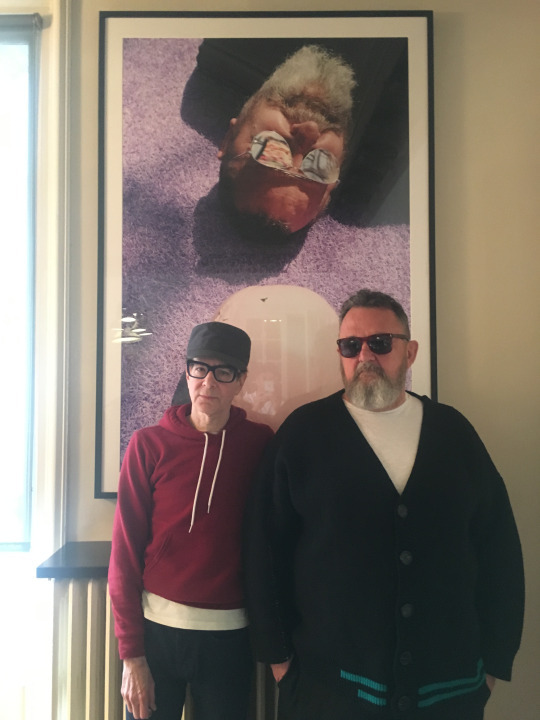
JS: What did you do when you came to New York? What was happening and did you go to the clubs?
MG: Of course. I have a good friend who we stayed with for three weeks. Florent from the restaurant, Florent. And he lived on Lafayette and Spring. So we got there, and there were like three bullet holes in the glass and maybe 25 more on the sidewalk, and we were just like “oh my God.” We went through the East Village and were like, “Where am I?” So the first night we decided to go out because a friend of his was like “Oh my God there is a Dolly Parton birthday party at Studio 54, you want to come?” And of course, I wanted to come. So we go and we took a taxi and the taxi cab driver was like “Are you going to 54? What do you want, quaaludes?” And we went to Studio 54.
JS: When did you go to the Paradise Garage?
MG: That was later. I went in 81. So I went to Studio 54, the Mudd Club was also 81.
JS: When you walked into Paradise Garage was it like anything you had ever experienced?
MG: I remember going up a ramp with candles or lights on the ground, going up that way and then turning a right like this, and then I remember hearing Numbers by Kraftwerk and that completely blew my mind.
I went to the Mudd Club when it was New Romantics time period. They were playing Soft Cell "Tainted Love” like ten times in a row.

JS: I worked there then. Started there in late 79 and played there until the late 1980. I went to the Blitz Club once which was pretty crazy.
MG: In England?
JS: Yes with Steve Strange.
MG: I didn’t go there. I never went clubbing in London really. But in New York, yes, and I went to Pyramid. I went to all the gay clubs. I went to the 12 West.
JS: Yeah the gay clubs were the most forward thinking. Back then The Garage, 12 West, Infinity, all those clubs were known for breaking new music and that’s where you heard all the best new records. Then that sort of went away.
MG: I see it the way it was at Champs Discques. I mean the store was super successful because in France we didn’t have many radio stations that would play that kind of stuff, and there was no way to get music. So we were playing really loud, all day long, the things we liked about every 10 to 15 minutes and people were grateful. They’re like “Oh my God, that’s so cool.”
JS: It was the only way to hear new music. Especially club music.
MG: Exactly, and even in the clubs there was a bit more freedom. Not freedom, but I could play a lot of things whenever I wanted because people were interested in discovering stuff, you know what I mean? Now people want to hear what they know or relate to. People don’t understand. They think a DJ should play whatever.
JS: “What do you mean you don’t have it?” And they hand you their phone. For me and for you I’m sure was the same. A great DJ was someone who would turn you on to new music. I didn’t want to hear only things I knew.
MG: Exactly, me too. I like to discover new stuff and older music I don’t know. There’s so much music. There’s new music, in-between music you forgot about in the past, you know or you forgot about, it’s like a full time job.
JS: Do you ever get involved in actually creating music for shows?
MG: Yeah. But I don’t create it myself. I work with people. I had a good experience with the Chromatics. That was really good and Johnny was super involved in it, that was really good.
JS: Have you ever been involved in mixing records or re-mixing?
MG: No, never.
JS: Produced your own tracks?
MG: No, I really don’t have the time. Plus, I think I would be too demanding, you know what I mean? Never happy with the result or whatever. I can be very demanding.
JS: You basically go from one season and start working on the next… How many shows do you do a year?
MG: Probably 100.
JS: Do you work with New York designers?
MG: Yes, of course. New York, also French designers, we work with Calvin Klein, Proenza Schouler, Rodarte, Michael Kors.
JS: What do you think about brands like, say Kenzo, or so many brands where the original designer is not involved anymore and they bring in new people to re-brand it? You’ve been around to know the original designers.
MG: Yeah, well I think some people do a good job. I mean I like what they do at Kenzo. I like their point of view, I like what they do with music.
JS: They use a lot of original music as well.
MG: Yeah, yeah which I think “why not?” They can use the music on the videos… I like the movies they make for perfume. They have a good thing going on.
JS: You’re very active on Instagram. Was Facebook ever a thing for you?
MG: Yeah. I started doing it on Facebook, but then I find the process on Instagram to be more direct, quicker, easier, and has a wider reach. I think it’s more fun.
JS: It’s one of the best things about what’s going on with the Internet. Communicating with people through images.
MG: Yeah. It’s fun because it’s like a jigsaw puzzle and then sometimes I’m like, “My God this picture, I’m sure I’m going to get this many likes” and it’s like a game. Like, okay I won again.
JS: Do you get disappointed when you get something that you think people are really going to get and then they don’t?
MG: No I don’t. I don’t know when the best time is to post. I don’t know any of that kind of stuff, I’m a very instinctive person.

JS: I see you posting stuff in the middle of the night and then early in the morning.
MG: Yeah, sometimes I wake up in the middle of the night for like half an hour and post.
JS: And do you just have a collection of images?
MG: Yeah, I collect them. I do collect and then there are some I research. Music, fashion, architecture, and all of the stuff I like. And of course the way it is when you find something, it leads you to something else, and something else, and something else, and that’s the way it works.
JS: And do you do your own images as well?
MG: Not really. Yeah sometimes I take pictures, otherwise, I don’t create anything especially for that. It’s found. It’s pictures I take, or it’s clippings from magazines, or it’s pictures from a book. This week I’m going to scan a few pictures from books I have, because I know you won’t be able to get them anywhere. So I like to share that too.
JS: You’ve got a nice following. People seem to love what you do and really react to it.
MG: I guess now I have quite a few, and with it comes the other side, I have a few haters.
JS: If you don’t have some haters, you’re not doing something right.
MG: That’s right! That’s what I thought as well.
#michel gaubert#paris#nyc#yes#just talk#justin strauss#interview#dj#sound designer#le palace#chanel#paradise garage#studio 54#champs disques#music#art#david bowie#just/talk
25 notes
·
View notes
Text
You Won’t Believe Which Celebrity Just Discovered Her Grandfather was a Nazi…
Earlier this week, comedian Chelsea Handler opened her loud, obnoxious mouth again to attack our new First Lady of the United States saying that she “barely speaks english.” Although it seems Handler is probably already aware of the fact that Mrs. Trump actually speaks four other languages on top of English, it seems Handler was reaching for something to get her into the spotlight just days before her TLC special, Who Do You Think You Are, is set to air.
In this new episode, Handler, 38, discovers exactly what role her grandfather, Karl Stoecker, played in one of history’s most atrocious genocides.
A historical family photo shows Karl and Elizabeth Stoecker, Handler’s maternal grandparents
She traces his path from Nazi soldier to American immigrant through documents and interviews with sources familiar with her family’s history.
Handler’s story is made all the more compelling by the fact that was she raised Jewish in a family of faith.
‘My father, I guess, made a deal with my mother when they had children that they were gonna be raised Jewish,’ Handler says. ‘So I connect with my Judaism, or the Jewish side of my family, more than anything else.’
Handler examines a notebook emblazoned with the Nazi swastika that purportedly belonged to her grandfather
But even after the new immigrant family settled down, the subject of wartime Germany was always avoided by her grandfather.
‘My German grandma definitely spoke about her life during the war way more than my grandfather did,’ Handler says. ‘He never spoke about it.’
A historical photo shows a group of German soldiers, one of whom could been Handler’s grandfather
All of this seems very interesting considering the fact that Handler uses her celebrity and all its platforms to spew hate and malice everywhere she can, only to find out that her grandfather was apart of the most evil regime that history has ever seen.
Handler may find it wise to sit down and keep quiet rather than speculate about what the new Trump Administration might do, rather than spew personal and illegitimate attacks on women and defenseless ten year old children.
Chelsea Handler explores her grandfather’s past as a Nazi soldier in a new episode of Who Do You Think You Are, which airs Tuesday
The post You Won’t Believe Which Celebrity Just Discovered Her Grandfather was a Nazi… appeared first on Tea Party Tribune.
Powered by WPeMatico
from http://www.therightnewsnetwork.com/you-wont-believe-which-celebrity-just-discovered-her-grandfather-was-a-nazi/
0 notes
Text
You Won’t Believe Which Celebrity Just Discovered Her Grandfather was a Nazi…
New Post has been published on http://www.therightnewsnetwork.com/you-wont-believe-which-celebrity-just-discovered-her-grandfather-was-a-nazi/
You Won’t Believe Which Celebrity Just Discovered Her Grandfather was a Nazi…
Earlier this week, comedian Chelsea Handler opened her loud, obnoxious mouth again to attack our new First Lady of the United States saying that she “barely speaks english.” Although it seems Handler is probably already aware of the fact that Mrs. Trump actually speaks four other languages on top of English, it seems Handler was reaching for something to get her into the spotlight just days before her TLC special, Who Do You Think You Are, is set to air.
In this new episode, Handler, 38, discovers exactly what role her grandfather, Karl Stoecker, played in one of history’s most atrocious genocides.
A historical family photo shows Karl and Elizabeth Stoecker, Handler’s maternal grandparents
She traces his path from Nazi soldier to American immigrant through documents and interviews with sources familiar with her family’s history.
Handler’s story is made all the more compelling by the fact that was she raised Jewish in a family of faith.
‘My father, I guess, made a deal with my mother when they had children that they were gonna be raised Jewish,’ Handler says. ‘So I connect with my Judaism, or the Jewish side of my family, more than anything else.’
Handler examines a notebook emblazoned with the Nazi swastika that purportedly belonged to her grandfather
But even after the new immigrant family settled down, the subject of wartime Germany was always avoided by her grandfather.
‘My German grandma definitely spoke about her life during the war way more than my grandfather did,’ Handler says. ‘He never spoke about it.’
A historical photo shows a group of German soldiers, one of whom could been Handler’s grandfather
All of this seems very interesting considering the fact that Handler uses her celebrity and all its platforms to spew hate and malice everywhere she can, only to find out that her grandfather was apart of the most evil regime that history has ever seen.
Handler may find it wise to sit down and keep quiet rather than speculate about what the new Trump Administration might do, rather than spew personal and illegitimate attacks on women and defenseless ten year old children.
Chelsea Handler explores her grandfather’s past as a Nazi soldier in a new episode of Who Do You Think You Are, which airs Tuesday
The post You Won’t Believe Which Celebrity Just Discovered Her Grandfather was a Nazi… appeared first on Tea Party Tribune.
Powered by WPeMatico
http://www.therightnewsnetwork.com/you-wont-believe-which-celebrity-just-discovered-her-grandfather-was-a-nazi/ %cats%
0 notes